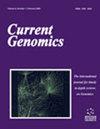Effect of Calebin-A on Critical Genes Related to NAFLD: A Protein-Protein Interaction Network and Molecular Docking Study
IF 1.4
4区 生物学
Q4 BIOCHEMISTRY & MOLECULAR BIOLOGY
引用次数: 0
Abstract
Background:: Calebin-A is a minor phytoconstituent of turmeric known for its activity against inflammation, oxidative stress, cancerous, and metabolic disorders like Non-alcoholic fatty liver disease(NAFLD). Based on bioinformatic tools, the present study explored the intersection of possible targets that interacted with Calebin-A and the essential genes involved in NAFLD. Subsequently, the details of the interaction of critical proteins with Calebin-A were investigated using the molecular docking technique. Methods:: We first probed the intersection of genes/ proteins between NAFLD and Calebin-A through online databases. Besides, we performed an enrichment analysis using the ClueGO plugin to investigate signaling pathways and gene ontology. Next, we evaluate the possible interaction of Calebin-A with significant hub proteins involved in NAFLD through a molecular docking study. Results:: We identified 87 intersection genes Calebin-A targets associated with NAFLD. PPI network analysis introduced 10 hub genes (TP53, TNF, STAT3, HSP90AA1, PTGS2, HDAC6, ABCB1, CCT2, NR1I2, and GUSB). In KEGG enrichment, most were associated with Sphingolipid, vascular endothelial growth factor A (VEGFA), C-type lectin receptor, and mitogen-activated protein kinase (MAPK) signaling pathways. The biological processes described in 87 intersection genes are mostly concerned with regulating the apoptotic process, cytokine production, and intracellular signal transduction. Molecular docking results also directed that Calebin-A had a high affinity to bind hub proteins linked to NAFLD. Conclusion:: Here, we showed that Calebin-A, through its effect on several critical genes/ proteins and pathways, might repress the progression of NAFLD.Calebin-A 对非酒精性脂肪肝相关关键基因的影响:蛋白质-蛋白质相互作用网络和分子对接研究
背景姜黄素-A是姜黄的一种次要植物成分,具有抗炎、抗氧化、抗癌和抗非酒精性脂肪肝等代谢性疾病的活性。本研究基于生物信息学工具,探索了与 Calebin-A 相互作用的可能靶点和非酒精性脂肪肝相关重要基因的交叉点。随后,利用分子对接技术研究了关键蛋白与 Calebin-A 相互作用的细节。研究方法首先,我们通过在线数据库探究了非酒精性脂肪肝和Calebin-A之间的基因/蛋白质交叉。此外,我们还使用 ClueGO 插件对信号通路和基因本体进行了富集分析。接下来,我们通过分子对接研究评估了Calebin-A与涉及非酒精性脂肪肝的重要枢纽蛋白之间可能存在的相互作用。结果我们发现了87个与非酒精性脂肪肝相关的Calebin-A靶标交叉基因。PPI网络分析引入了10个枢纽基因(TP53、TNF、STAT3、HSP90AA1、PTGS2、HDAC6、ABCB1、CCT2、NR1I2和GUSB)。在 KEGG 富集中,大部分与鞘磷脂、血管内皮生长因子 A(VEGFA)、C 型凝集素受体和丝裂原活化蛋白激酶(MAPK)信号通路有关。87 个交叉基因所描述的生物过程主要涉及调节细胞凋亡过程、细胞因子产生和细胞内信号转导。分子对接结果还表明,Calebin-A 与与非酒精性脂肪肝相关的枢纽蛋白有很高的结合亲和力。结论我们在这里发现,Calebin-A 通过影响几个关键基因/蛋白和通路,可能会抑制非酒精性脂肪肝的进展。
本文章由计算机程序翻译,如有差异,请以英文原文为准。
求助全文
约1分钟内获得全文
求助全文
来源期刊

Current Genomics
生物-生化与分子生物学
CiteScore
5.20
自引率
0.00%
发文量
29
审稿时长
>0 weeks
期刊介绍:
Current Genomics is a peer-reviewed journal that provides essential reading about the latest and most important developments in genome science and related fields of research. Systems biology, systems modeling, machine learning, network inference, bioinformatics, computational biology, epigenetics, single cell genomics, extracellular vesicles, quantitative biology, and synthetic biology for the study of evolution, development, maintenance, aging and that of human health, human diseases, clinical genomics and precision medicine are topics of particular interest. The journal covers plant genomics. The journal will not consider articles dealing with breeding and livestock.
Current Genomics publishes three types of articles including:
i) Research papers from internationally-recognized experts reporting on new and original data generated at the genome scale level. Position papers dealing with new or challenging methodological approaches, whether experimental or mathematical, are greatly welcome in this section.
ii) Authoritative and comprehensive full-length or mini reviews from widely recognized experts, covering the latest developments in genome science and related fields of research such as systems biology, statistics and machine learning, quantitative biology, and precision medicine. Proposals for mini-hot topics (2-3 review papers) and full hot topics (6-8 review papers) guest edited by internationally-recognized experts are welcome in this section. Hot topic proposals should not contain original data and they should contain articles originating from at least 2 different countries.
iii) Opinion papers from internationally recognized experts addressing contemporary questions and issues in the field of genome science and systems biology and basic and clinical research practices.
 求助内容:
求助内容: 应助结果提醒方式:
应助结果提醒方式:


